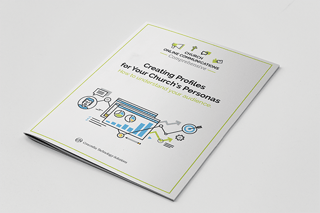
Last week, I talked about determining the personas your church communications will be developed for. This week, we’re going to work on developing profiles for those personas.
First, we’re going to look at what types of information your personas should include. Then we’ll look at how you can compile that information. At the end of the post, you can download a free worksheet that will help you assemble that information into easy-to-understand profiles. Keep these profiles on hand so you can check your communication efforts against them and so you can easily train new volunteers on your church’s communication strategy.
Why Develop Profiles for Personas?
Profiles for your personas breathe humanity back into your research. At churches, our work is about people. When we determine personas, we make generalizations about people to place them into groups. But it’s essential to remember that these personas are based on real people in your congregation—people who have likes and dislikes, comforts and pain points in their lives.
Persona profiles also provide strong context for your communications. Well defined personas make it easier to consistently shape messages for the intended audiences.
Personas should make you think of more than one individual within your congregation. But at the same time, each persona should be developed enough that you feel like you know the fictional individual personally. When writing a persona profile, you’ll want to be specific about characteristics but not so specific that you describe a real individual in your church. Remove any information that could be linked to a member of your congregation, but keep the communication value for future reference.
What to Include in Persona Profiles
As you write the profiles, think of the information you would keep in mind when crafting a message to that person. Here are some ideas to help you get started.
Demographic Information
Give your persona some personality and talk about her background. How old is she? Is she in school or working? Is she single or married? Does she have kids? Did she grow up in the city or the country? Each of these items will help you understand the context in which she will understand your messages whenever you communicate with her.
Educational Background
Does your persona prefer to learn on the job or in a classroom-like setting? Does he place more value on work experience or formal education? Give your persona an educational background that details what he has accomplished. This will shape how you approach inviting him to participate in activities in which he would have to learn new information or skills.
Technological Skill Level
Is your persona comfortable with computers or does she shy away from them? Is it easy for her to learn new skills on computers or is it difficult and time-consuming for her? This will affect the types of tasks you give her when she is participating in church activities. It will also affect the channels you use to communicate with her; if technology is her thing, then forget about printing a targeted announcement in the bulletin and instead just post a message on Facebook.
Faith Background
Has he always been a Christian? If not, what religion did he follow before, if any? If he became a Christian later in life, what caused him to turn to the church? Has he always been within your church’s denomination, or if not, which denomination(s) was he previously part of? How much has he been instructed in the Christian faith? The answers to these questions will guide the types of things you talk to him about and how you talk about them. For instance, if he became a Christian as an adult, it wouldn’t be appropriate to send him a message saying, “Remember being confirmed in eighth grade?”
Church Involvement
How active is your persona and what kind of activities is she involved with? Does she attend worship regularly? What about Bible study? Is she the first to sign up as a volunteer for the church potluck or is she the one who joins the annual mission trip to Mexico? Knowing these types of information will help you determine what types of things you might need to encourage her to join and what things she’ll eagerly participate in on her own.
Interests, Skills, and Passions
What does he do with his free time? What is he good at or uniquely qualified for? What causes is he an advocate for? Detailing his likes and dislikes will help you recognize what activities he might be interested in joining. These preferences can also help you determine which lists to include him on with your communications.
Goals, Hopes, and Intentions
What does she want for her life or the world around her? Why is she a member of your church? What does she seek from it? Where does she hope to go in her faith life? These serious questions will help you determine which of your church’s goals most apply to her and how your church can best serve her.
This is just the beginning; there are plenty of additional details you could include in your persona profiles. Think about your church and its goals and see if there are additional characteristics your personas should include.
How Do You Compile This Information?
Often in churches, the communications team is a one-person team. How do you collect so much information on your own? The best thing you can do is start talking with the church staff, ministry leaders, longtime members, and those who regularly attend worship.
Informal Conversations
As you talk with people in your congregation, begin asking questions related to the information you need to collect. This is an informal process, so just talk naturally. When you’re done, jot a few notes down to help you remember what you talked about. Since your persona profiles won’t include people’s specific stories, you just need to remember the themes of these conversations.
Interviews
Setting up dedicated time to interview a handful of members one-on-one is a great way to get thorough responses. Be honest that you’re collecting information for your research, and some people will surely be willing to help. Don’t ignore the fact that these people chose to talk with you, so some results may be skewed.
Surveys
To collect data in bulk, sending a survey to your entire church can be a very helpful tool. Not only does this get you a large sample of data to work with, but it is also a fast way to get the details you need to begin assigning personas.

Need some help getting started?
Download the free PDF Creating Profiles for Your Church’s Personas. This sample persona profile and blank template help you create profiles for your church’s audiences, helping you better understand and communicate with them.

Free Training Course
This blog post was part of the training series Church Online Communications Comprehensive. All the course materials are available online for free, and you can move through the course at your own pace. Start working toward an effective online communications strategy for your church today!






